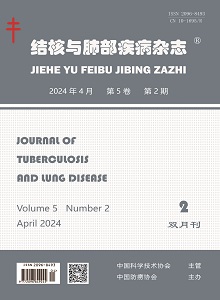Objective To understand the nutritional status of patients with newly diagnosed smear positive pulmonary tuberculosis and to explore correlation between nutritional status and chest CT findings in those patients. Methods Basic information of 296 newly diagnosed pulmonary tuberculosis patients with positive sputum smear acid-fast bacilli testing results from April 2019 to September 2019 were collected. Among them, 204 were male and 92 were female, age range 18-72 years, median age 38 years. According to body mass index (BMI) <18.5 or albumin (ALB) <30 g/L, those patients were divided into malnutrition group (122 cases) and non-malnutrition group (174 cases). The incidence of malnutrition was 41.2% (122/296). Morphological and lesion characteristics of chest imaging of those two groups were compared. Results Proportion of morphological features of chest CT(cavity, pulmonary consolidation shadow, pleural effusion, mediastinal hilar lymph node enlargement, tree bud sign, interstitial changes, patch shadow, cord shadow, calcification, small nodules) in the malnutrition group was 82.0% (100/122), 89.3% (109/122), 24.6% (30/122), 41.8% (51/122), 32.0% (39/122), 9.8% (12/122), 68.9% (84/122), 18.9% (23/122), 16.4% (20/122), 39.3% (48/122) respectively, which was similar to the non-malnutrition group (77.6% (135/174), 89.7% (156/174), 19.5% (34/174), 38.5% (67/174), 29.3% (51/174), 11.5% (20/174), 67.8% (118/174), 20.1% (35/174), 6.9% (12/174), 47.7% (83/174)),without statistically significant differences (χ2=0.841, 0.007, 1.079, 0.325, 0.625, 0.205, 0.036, 0.073, 6.708, 2.030, all P>0.05). The proportion of lung lesions ≥4 lung fields and the number of cavities ≥2 in malnutrition group was 66.4% (81/122) and 69.7% (85/122), higher than that in the non-malnutrition group (42.0% (73/174) and 37.4% (65/174)),with statistically significant differences (χ 2=17.162, 29.963,all P<0.001). The proportion of lesions being at the posterior segment of the upper lobe tip and the dorsal segment of the lower lobe in malnutrition group was 89.3% (109/122), similar to the non-malnutrition group (86.2% (150/174)), without statistically significant difference (χ 2=0.645, P>0.05). Conclusion Patients with newly diagnosed smear-positive pulmonary tuberculosis with malnutrition got more lung fields affected than patients without malnutrition, and were more likely to have multiple cavities.

 Wechat
Wechat